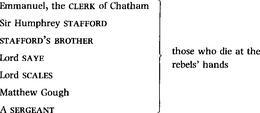A variety of internal evidence suggests that the Folio’s Part One was composed after The First Part of the Contention and Richard, Duke of York, so we depart from the Folio order, though a reader wishing to read the plays in their narrative sequence will read Henry VI, Part One before the other two plays. The dates of all three are uncertain, but Part One is alluded to in 1592, when it was probably new. The First Part of the Contention probably belongs to 1590-1.
The play draws extensively on English chronicle history for its portrayal of the troubled state of England under Henry VI (1421-71). It dramatizes the touchingly weak King’s powerlessness against the machinations of his nobles, especially Richard, Duke of York, himself ambitious for the throne. Richard engineers the Kentish rebellion, led by Jack Cade, which provides some of the play’s liveliest episodes; and at the play’s end Richard seems poised to take the throne.
Historical events of ten years (11445-55) are dramatized with comparative fidelity within a coherent structure that offers a wide variety of theatrical entertainment. Though the play employs old-fashioned conventions of language (particularly the recurrent classical references) and of dramaturgy (such as the horrors of severed heads), its bold characterization, its fundamentally serious but often ironically comic presentation of moral and political issues, the powerful rhetoric of its verse, and the vivid immediacy of its prose have proved highly effective in its rare modern revivals.
THE PERSONS OF THE PLAY
Of the King’s Party
KING HENRY VI
QUEEN MARGARET
William de la Pole, Marquis, later Duke, of SUFFOLK, the Queen’s lover
Duke Humphrey of GLOUCESTER, the Lord Protector, the King’s uncle
Dame Eleanor Cobham, the DUCHESS of Gloucester
CARDINAL BEAUFORT, Bishop of Winchester, Gloucester’s uncle and the King’s great-uncle
Duke of BUCKINGHAM
Duke of SOMERSET
Old Lord CLIFFORD
YOUNG CLIFFORD, his son
Of the Duke of York’s Party
Earl of SALISBURY
Earl of WARWICK, his son
The petitions and the combat
Two or three PETITIONERS
Thomas HORNER, an armourer
PETER Thump, his man
Three NEIGHBOURS, who drink to Horner
Three PRENTICES, who drink to Peter
The conjuration
Margery Jordan, a WITCH
Roger BOLINGBROKE, a conjurer
ASNATH, a spirit
The false miracle
Simon SIMPCOX
SIMPCOX’S WIFE
The MAYOR of Saint Albans
Aldermen of Saint Albans
A BEADLE of Saint Albans
Townsmen of Saint Albans
Eleanor’s penance
Gloucester’s SERVANTS
Two SHERIFFS of London
Sir John STANLEY
HERALD
The murder of Gloucester
Two MURDERERS
COMMONS
The murder of Suffolk
CAPTAIN of a ship
MASTER of that ship
The Master’s MATE
Walter WHITMORE
Two GENTLEMEN
The Cade Rebellion
Jack CADE, a Kentishman suborned by the Duke of York


Three or four CITIZENS of London
Alexander IDEN, an esquire of Kent, who kills Cade
Others
VAUX, a messenger
APOST
MESSENGERS
A SOLDIER
Attendants, guards, servants, soldiers, falconers
The First Part of the Contention of the Two Famous Houses of York and Lancaster
1.1 Flourish of trumpets, then hautboys. Enter, at one door, King Henry and Humphrey Duke of Gloucester, the Duke of Somerset, the Duke of Buckingham, Cardinal Beaufort,⌈and others⌉. Enter, at the other door, the Duke of York, and the Marquis of Suffolk, and Queen Margaret, and the Earls of Salisbury and Warwick
SUFFOLK (kneeling before King Henry)
As by your high imperial majesty
I had in charge at my depart for France,
As Procurator to your excellence,
To marry Princess Margaret for your grace,
So, in the famous ancient city Tours,
In presence of the Kings of France and Sicil,
The Dukes of Orléans, Calaber, Bretagne, and Alençon,
Seven earls, twelve barons, and twenty reverend
bishops,
I have performed my task and was espoused,
And humbly now upon my bended knee,
In sight of England and her lordly peers,
Deliver up my title in the Queen
To your most gracious hands, that are the substance
Of that great shadow I did represent—
The happiest gift that ever marquis gave,
The fairest queen that ever king received.
KING HENRY
Suffolk, arise. Welcome, Queen Margaret.
I can express no kinder sign of love
Than this kind kiss.
He kisses her
O Lord that lends me life,
Lend me a heart replete with thankfulness!
For thou hast given me in this beauteous face
A world of earthly blessings to my soul,
If sympathy of love unite our thoughts.
QUEEN MARGARET
Th’excess of love I bear unto your grace
Forbids me to be lavish of my tongue
Lest I should speak more than beseems a woman.
Let this suffice: my bliss is in your liking,
And naught can make poor Margaret miserable
Unless the frown of mighty England’s King.
KING HENRY
Her sight did ravish, but her grace in speech,
Her words yclad with wisdom’s majesty,
Makes me from wond’ring fall to weeping joys,
Such is the fullness of my heart’s content.
Lords, with one cheerful voice, welcome my love.
LORDS (kneeling)
Long live Queen Margaret, England’s happiness.
QUEEN MARGARET We thank you all.
Flourish. ⌈They all rise⌉
SUFFOLK (to Gloucester)
My Lord Protector, so it please your grace,
Here are the articles of contracted peace
Between our sovereign and the French King Charles,
For eighteen months concluded by consent.
GLOUCESTER (reads) Imprimis: it is agreed between the French King Charles and William de la Pole, Marquis of Suffolk, ambassador for Henry, King of England, that the said Henry shall espouse the Lady Margaret, daughter unto René, King of Naples, Sicilia, and Jerusalem, and crown her Queen of England, ere the thirtieth of May next ensuing.